Comparing Two 1TB NVMe Drives with Same NAND, Same Controller: XPG SX8200 Pro vs HP EX950
by Billy Tallis on February 6, 2019 11:30 AM ESTAnandTech Storage Bench - The Destroyer
The Destroyer is an extremely long test replicating the access patterns of very IO-intensive desktop usage. A detailed breakdown can be found in this article. Like real-world usage, the drives do get the occasional break that allows for some background garbage collection and flushing caches, but those idle times are limited to 25ms so that it doesn't take all week to run the test. These AnandTech Storage Bench (ATSB) tests do not involve running the actual applications that generated the workloads, so the scores are relatively insensitive to changes in CPU performance and RAM from our new testbed, but the jump to a newer version of Windows and the newer storage drivers can have an impact.
We quantify performance on this test by reporting the drive's average data throughput, the average latency of the I/O operations, and the total energy used by the drive over the course of the test.
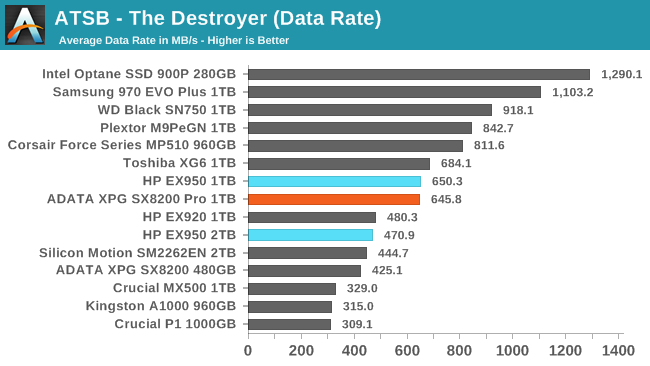
The 1TB models of the ADATA SX8200 Pro and HP EX950 go a long way toward catching up with other current high-end drives, but ultimately their overall performance on The Destroyer is inadequate. The 2TB EX950 doesn't even outperform last year's 1TB EX920.
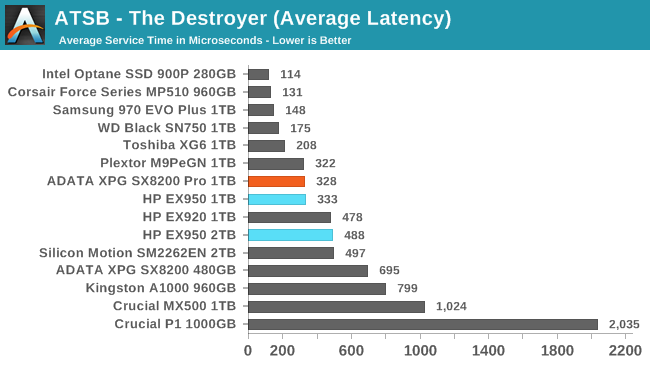
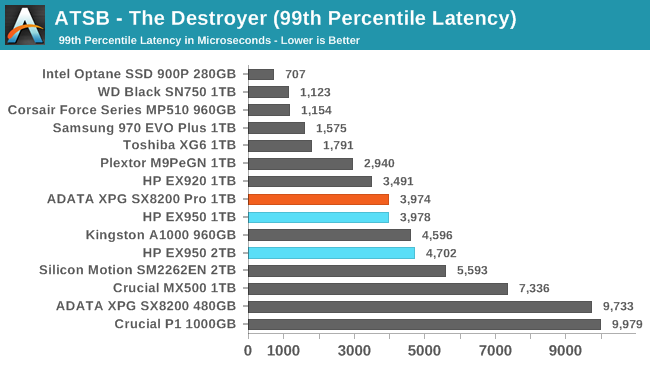
The average latency of the 1TB SM2262EN drives on The Destroyer is a significant improvement over their predecessors, but as with the average data rate it doesn't bring them up to the level of other recent high-end drives. The 99th percentile latency has actually regressed slightly from what the 1TB HP EX920 provided. The 2TB EX950 is slower in both metrics than the 1TB drives, but the 99th percentile latency score has improved from the pre-production firmware we tested last year.
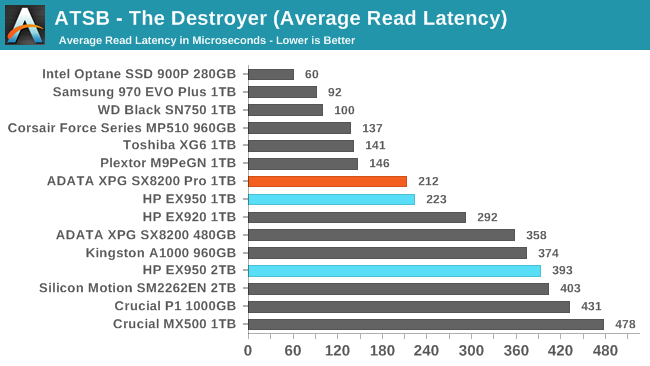
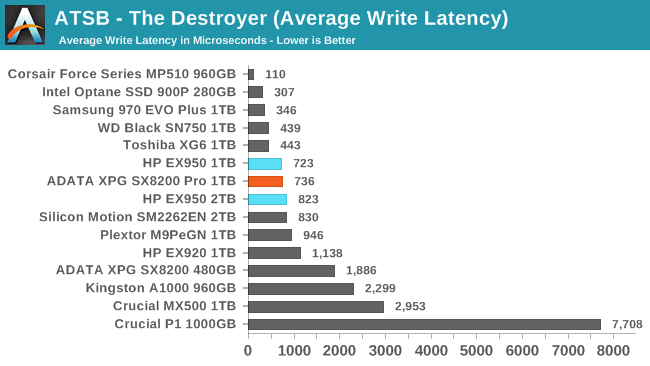
The 2TB HP EX950 has significantly worse average read latency than the 1TB models of the EX950 or EX920, but the average write latency is comparable to the 1TB EX950 and a clear improvement over the EX920. Regardless of capacity, the SM2262EN drives still have a lot of room for improving latency on The Destroyer.
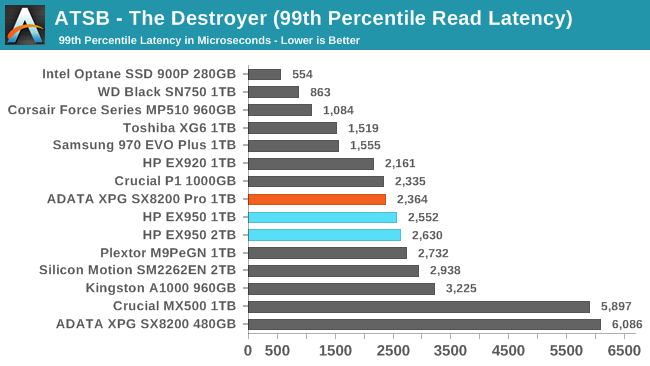
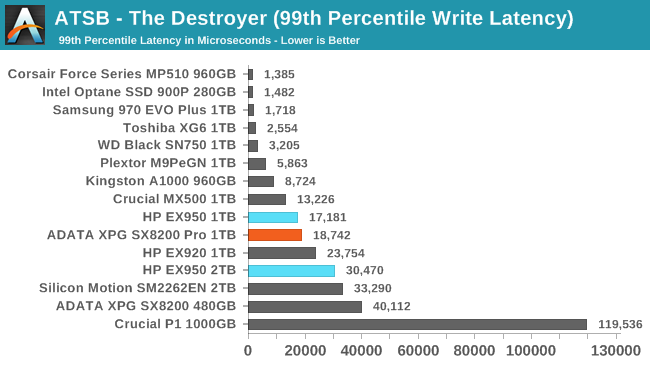
Overall, the 99th percentile read latency scores from the SM2262EN drives are closer to being competitive with other recent high-end drives than the 99th percentile write latencies, but both need to improve—especially the read QoS that has regressed slightly from the HP EX920. The SM2262 and SM2262EN drives have worse 99th percentile write latency on The Destroyer than the Crucial MX500, a SATA drive that is itself powered by a Silicon Motion controller.
For average latency, the 2TB EX950's weakness was on read operations, but when looking at 99th percentiles, it's writes that are a problem for the 2TB drive, though not as much as with the pre-production firmware.
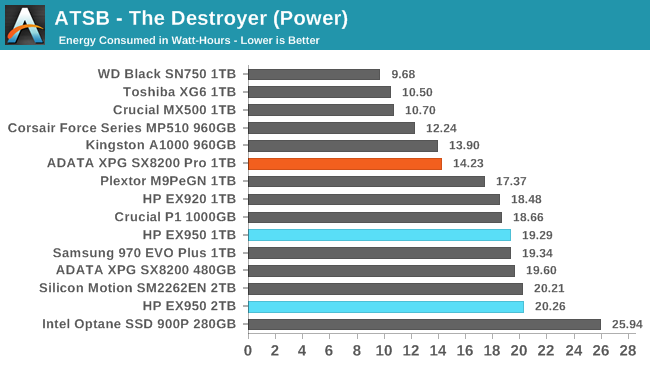
The ADATA SX8200 Pro used significantly less power during The Destroyer than the HP EX950, putting the SX8200 Pro well ahead of the entire collection of SMI-based NVMe drives and close to the Phison E12-based Corsair MP510. WD and Toshiba remain the only ones to actually tie or surpass the power efficiency of SATA drives on this test. The 2TB EX950 unsurprisingly consumes a bit more energy than the 1TB model, thanks to having more memory to keep powered and due to firmware optimizations that are more ill-suited to this test than how the 1TB models behave.










42 Comments
View All Comments
wolfesteinabhi - Wednesday, February 6, 2019 - link
this is a bit of worrying trend where we are getting same products with new/updated firmware...the firmware that was essentially free earlier...and get improved performance...now they have to pay and buy new hardware for it.ERJ - Wednesday, February 6, 2019 - link
When is the last time you updated the firmware on your hard drive? RAID card / BIOS / Video Card sure, but hard drive?Now, you could argue that the controller is essentially part of the hard drive in this case but still.
jeremyshaw - Wednesday, February 6, 2019 - link
Hard drive? They aren't that old, right? You do remember HDD firmware updates. As for SSDs, I've recently updated the firmware on my SSDs. Heck, even my monitor has been through a firmware update. Like the SSD updates, the monitor firmware affected performance and compatibility.jabber - Thursday, February 7, 2019 - link
I used to worry about SSD firmware updates when I was getting in 1 every blue moon and it had novelty value but 200+ SSDs later I now just don't bother. At the end of the day getting an extra 30MBps just isnt the boost it was all those years ago.ridic987 - Wednesday, February 6, 2019 - link
We are discussing SSD's not hard drive. Literally the thing what he is saying most applies to.Samus - Thursday, February 7, 2019 - link
I agree, the lack of SSD firmware updates - particularly what WD has pulled with the Black SSD's - is troubling. To artificially limit product improvement through restricting software updates and requiring the user to purchase an entirely new product sets a bad precedent. They could at least do what HP does in the server market and charge for support beyond the warranty. After a server warranty is up (typically 3 years) you have to pay for firmware and BIOS updates for servers. This isn't a terrible policy, at least it wasn't until meltdown\spectre hit and all the sudden it seemed somewhat necessary to update server firmware that were many years old.Hard drives get firmware updates all the time - just not from the manufacturers. They typically applicable to retail products for reasons. But go ahead and look up a random OEM PC's drivers from Dell or HP and you might see various firmware updates available for the hard disk models those PC's shipped with.
Are they important though? Rarely. Barring any significant bug, hard disks have little to benefit from firmware updates as they are so mechanically limited and the controllers are generally quite mature, having been based on incremental generations of past firmware. This could all change as MAMR and HAMR become more mainstream, the same way the only hard disk firmware I remember being common were the WD Black2 (the SSD+HDD hybrid) and various Seagate SSHD's - for obvious reasons. The technology was new, and there are benefits to updating the SSD firmware as improvements are made through testing and customer feedback.
melgross - Thursday, February 7, 2019 - link
I think of it the other way around. Unless there’s a serious bug in the firmware, firmware upgrades are a gift, that manufacturers don’t have to give.The fact is that even when they are available, almost no one applies them. That’s true even for most who know they’re available. It’s alwasys dangerous to upgrade firmware on a product so central to needs. If there’s an unfounded bug in the new upgrade, that could be worse than firmware that’s already working just fine, but isn’t quite as fast as you might wish foe.
I’ve never seen any major upgrade in performance from a drive firmware upgrade. Ever.
FullmetalTitan - Thursday, February 7, 2019 - link
Those of us around for sandforce controllers remember well the pains of updating SSD firmware to make our drives useableDigitalFreak - Wednesday, February 6, 2019 - link
Billy - how far are we away from having 4TB M.2 NVMe drives?Billy Tallis - Wednesday, February 6, 2019 - link
Most SSD vendors could produce 4TB double-sided M.2 drives using off the shelf parts. Putting 4TB on a single-sided module would require either going with a DRAMless controller, stacking DRAM and the controller on the same package, or using 1Tb+ QLC dies instead of TLC.So currently any 4TB M.2 drive would have at least some significant downside that either compromises performance, restricts compatibility, or drives the price up well beyond twice that of a 2TB M.2 drive. There's simply not enough demand for such drives, and likely won't be anytime soon.